MAGNETIC MOMENTS, Number 1
(originally printed in Speleonics 1, May 1985)By Ian Drummond
This article is the first of several on the general topic of magnetic coupling between underground and surface loop antennas. I hope they will give practical information to people building radios, to allow them to make use of information from other devices, and to provide indications on how to design radios for special applications.
If I had had access to this information when Julian Coward and I started our units, we could have saved hours, dollars and got more range! All articles will have examples from my own experience.
The articles will be about the general setup shown in Fig. 1.

- Effects of conductive earth
- Attenuation of signal
- False nulls, limits to position location methods - Antenna design
- Air-core loops for transmission
- Air-core loops for receiving
- Ferrite-core loops - Noise
- Noise spectra
- Limits to range of cave radios
- Coherent continuous-wave radios
In this first article I want to deal with the problem of attenuation of the magnetic field by a conductive earth between the transmitting and receiving loops. For example, consider this problem. I have a radio operating at 115.4 kHz and l0 w power. It drives a 0.71 m square loop and I can hear speech 200 m away under optimum conditions (low noise and dry alpine terrain). I want to make a small "walkie-talkie" to give speech to 50m, but with the antenna small enough to keep in my side-pack so that I don’t have to stop and set it up each time I want to use it. Is this possible?
To solve the problem I can calculate the magnetic field produced 200 m from my existing antenna and then calculate the size and current needed to give the same field 50m away.
Before calculating the field I want to introduce the idea of Skin-Depth, which is a distance characterized by the frequency of the magnetic field, by the conductivity of the medium, and by its magnetic susceptibility. For limestone (and most other rocks) the susceptibility is equal to that of free space (4 p x l0-7 Henries/m) so the skin depth depends only on the frequency and conductivity. The formula is:
Skin-depth (metres) = 1/Ö (p fm s )
| where: f = | frequency (Hz) |
| m = | 4p x l0-7 H/m |
| s = | conductivity (mho/m) |
The value of the skin-depth can be calculated or looked-up in
fig. 2.
For example, dry limestone terrain has a low conductivity of about 0.001 mho/m so at 115.4 kHz, the skin-depth is about 50 m.
The magnetic field can now be calculated on the axis of the 0.71 m loop, 200 m away, using the following formula:
H (magnetic field, A/m) = n I A G / (2 p d3)
where: n = number of turns I = current (amps) A = Area of loop (m2) d = distance (m) and G = tabulated factor (fig. 3)
For my loop:
n = 70, I = 0.32 amps, A =0.5 m2, d = 200m,
and from fig. 3 at 200/50 = 4 skin depths, G = 0.15
So, H = 3 x 10-8 A/m
Suppose for my "walkie-talkie" I wind 100 turns on a 3 1/2" diameter plastic pipe (area = 0.0062 m2). I want to know what current I would need to give me a field of 3 x 10-8 A/m at a distance of 50m, or 1 skin depth, when G = 0.84.
So, 3 x 10-8 A/m = (l00 x I x 0.0062 x 0.84)/ (2 p
x 503)
So, I = 0.04 amps.
This is a small current, easily produced in such a loop, so the idea of the small walkie-talkie is not unreasonable. The smaller loop will absorb less power from the magnetic field at the receiver which may need more gain. I will cover that aspect in a later article.
Next time I will discuss how to design an air-core loop to give a known N, I, A,; how much power it can handle.
References
Fig. 3 is from ‘Performance of manpack EM location equipment in trapped-miner location tests" by A. J. Farstad, in NTIS PB231154 "Thru-the-earth electromagnetics workshop" (1973).
The diagram is based on the work of J.R. Wait, for example, Proc. IEEE, June 1971 p. l033-l035.

| Skin-depth | G |
| 0 | 1.00 | 1 | 0.84 | 2 | 0.55 | 3 | 0.30 | 4 | 0.15 | 5 | 0.068 | 6 | 0.032 | 7 | 0.0103 | 8 | 0.0054 | 9 | 0.0027 | 10 | 0.0010 |
Figure 3. |
Return to the Top of the Page
Copyright © 2000 Communications & Electronics Section of the NSS, Inc. - All Rights Reserved.